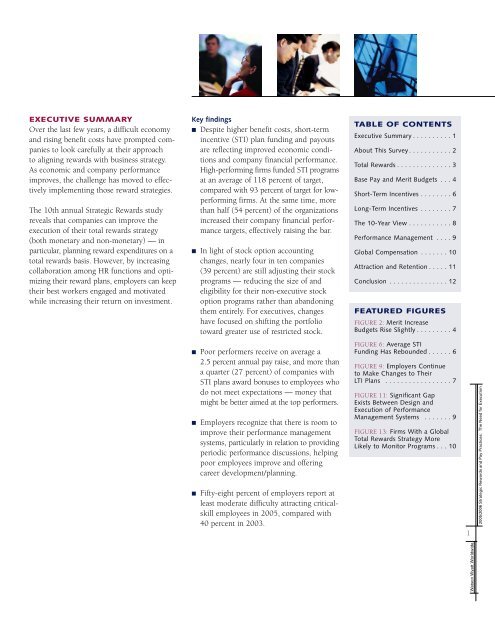The Need for Execution - San Antonio Compensation Association
The Need for Execution - San Antonio Compensation Association
The Need for Execution - San Antonio Compensation Association
Create successful ePaper yourself
Turn your PDF publications into a flip-book with our unique Google optimized e-Paper software.
EXECUTIVE SUMMARY<br />
Over the last few years, a difficult economy<br />
and rising benefit costs have prompted companies<br />
to look carefully at their approach<br />
to aligning rewards with business strategy.<br />
As economic and company per<strong>for</strong>mance<br />
improves, the challenge has moved to effectively<br />
implementing those reward strategies.<br />
<strong>The</strong> 10th annual Strategic Rewards study<br />
reveals that companies can improve the<br />
execution of their total rewards strategy<br />
(both monetary and non-monetary) — in<br />
particular, planning reward expenditures on a<br />
total rewards basis. However, by increasing<br />
collaboration among HR functions and optimizing<br />
their reward plans, employers can keep<br />
their best workers engaged and motivated<br />
while increasing their return on investment.<br />
Key findings<br />
■ Despite higher benefit costs, short-term<br />
incentive (STI) plan funding and payouts<br />
are reflecting improved economic conditions<br />
and company financial per<strong>for</strong>mance.<br />
High-per<strong>for</strong>ming firms funded STI programs<br />
at an average of 118 percent of target,<br />
compared with 93 percent of target <strong>for</strong> lowper<strong>for</strong>ming<br />
firms. At the same time, more<br />
than half (54 percent) of the organizations<br />
increased their company financial per<strong>for</strong>mance<br />
targets, effectively raising the bar.<br />
■ In light of stock option accounting<br />
changes, nearly four in ten companies<br />
(39 percent) are still adjusting their stock<br />
programs — reducing the size of and<br />
eligibility <strong>for</strong> their non-executive stock<br />
option programs rather than abandoning<br />
them entirely. For executives, changes<br />
have focused on shifting the portfolio<br />
toward greater use of restricted stock.<br />
TABLE OF CONTENTS<br />
Executive Summary . . . . . . . . . . 1<br />
About This Survey. . . . . . . . . . . 2<br />
Total Rewards . . . . . . . . . . . . . . 3<br />
Base Pay and Merit Budgets . . . 4<br />
Short-Term Incentives . . . . . . . . 6<br />
Long-Term Incentives . . . . . . . . 7<br />
<strong>The</strong> 10-Year View . . . . . . . . . . . 8<br />
Per<strong>for</strong>mance Management . . . . 9<br />
Global <strong>Compensation</strong> . . . . . . . 10<br />
Attraction and Retention . . . . . 11<br />
Conclusion . . . . . . . . . . . . . . . 12<br />
FEATURED FIGURES<br />
FIGURE 2: Merit Increase<br />
Budgets Rise Slightly . . . . . . . . . 4<br />
■ Poor per<strong>for</strong>mers receive on average a<br />
2.5 percent annual pay raise, and more than<br />
a quarter (27 percent) of companies with<br />
STI plans award bonuses to employees who<br />
do not meet expectations — money that<br />
might be better aimed at the top per<strong>for</strong>mers.<br />
■ Employers recognize that there is room to<br />
improve their per<strong>for</strong>mance management<br />
systems, particularly in relation to providing<br />
periodic per<strong>for</strong>mance discussions, helping<br />
poor employees improve and offering<br />
career development/planning.<br />
■ Fifty-eight percent of employers report at<br />
least moderate difficulty attracting criticalskill<br />
employees in 2005, compared with<br />
40 percent in 2003.<br />
FIGURE 6: Average STI<br />
Funding Has Rebounded . . . . . . 6<br />
FIGURE 9: Employers Continue<br />
to Make Changes to <strong>The</strong>ir<br />
LTI Plans . . . . . . . . . . . . . . . . . 7<br />
FIGURE 11: Significant Gap<br />
Exists Between Design and<br />
<strong>Execution</strong> of Per<strong>for</strong>mance<br />
Management Systems . . . . . . . 9<br />
FIGURE 13: Firms With a Global<br />
Total Rewards Strategy More<br />
Likely to Monitor Programs . . . 10<br />
1<br />
2005/2006 Strategic Rewards and Pay Practices: <strong>The</strong> <strong>Need</strong> <strong>for</strong> <strong>Execution</strong><br />
Watson Wyatt Worldwide


